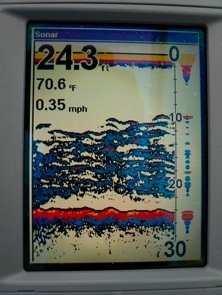bay bridge
 Have you ever wondered why fish seem to turn on and off at different times during the day? If you’re like me you’ve probably gone for hours without catching a fish, hardly even getting a strike. Then, click, just like turning on a light switch every cast results in a fish. Fishermen refer to this phenomenon as “the bite,” as in, “The bite turned-on about 3:00 PM and off at dark.” Read More!
Have you ever wondered why fish seem to turn on and off at different times during the day? If you’re like me you’ve probably gone for hours without catching a fish, hardly even getting a strike. Then, click, just like turning on a light switch every cast results in a fish. Fishermen refer to this phenomenon as “the bite,” as in, “The bite turned-on about 3:00 PM and off at dark.” Read More!
 It’s sometimes said that good fishermen think like a fish. While no one really knows what fish think, it’s usually possible to predict where they might be located based on climatic conditions and the time of year. Two very important factors to consider when looking for fish in the Chesapeake Bay are water temperature and salinity. Sometimes stripers congregate near underwater structure, at other times they travel in schools out in the open bay, but they always prefer specific depth zones which vary depending on the time of year. Fish are cold-blooded, so they’re more likely to be active in water that keeps them warmer in the winter and cooler in the summer. The “perfect” water temperature for stripers is around 68 degrees, but perfect conditions are rare. Since locating feeding fish is a fisherman’s primary challenge, it’s important to understand seasonally changing temperature zones in the Bay.
It’s sometimes said that good fishermen think like a fish. While no one really knows what fish think, it’s usually possible to predict where they might be located based on climatic conditions and the time of year. Two very important factors to consider when looking for fish in the Chesapeake Bay are water temperature and salinity. Sometimes stripers congregate near underwater structure, at other times they travel in schools out in the open bay, but they always prefer specific depth zones which vary depending on the time of year. Fish are cold-blooded, so they’re more likely to be active in water that keeps them warmer in the winter and cooler in the summer. The “perfect” water temperature for stripers is around 68 degrees, but perfect conditions are rare. Since locating feeding fish is a fisherman’s primary challenge, it’s important to understand seasonally changing temperature zones in the Bay.
Salinity and temperature are closely related in the Bay. Striped bass are classified as anadromous fish, meaning they live primarily in salt water but migrate to fresh water to spawn. While they can live and thrive in fresh water, they prefer water with some salinity. Scientific opinions are mixed as to the optimum salt content, but there’s no denying that salinity influences the behavior of rockfish in the Bay. This is especially true in the spring and fall when many fish are traveling to and from the ocean. Read More!

The Chesapeake Bay Bridge, officially named the William Preston Lane Jr Memorial Bridge, crosses the Chesapeake Bay near Annapolis, MD. Officially opened as one span with 2-way traffic in 1952, it replaced two ferries that connected the metro areas of Washington DC and Baltimore to Maryland’s Eastern Shore. A parallel northern span was opened in 1973 adding 3 more lanes. When the bridge was built it was the world’s longest continuous over-water steel structure at 4.35 miles long. It has more than 400 steel & concrete pilings and over 2 miles of rip-rap lined access roads creating an exceptional habitat for striped bass. Read More!


